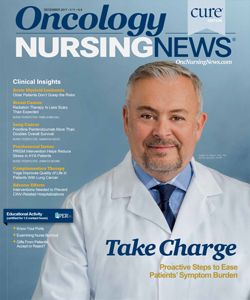Take Charge: Proactive Steps to Ease Patients' Symptom Burden
Early palliative care and web-based systems are effective solutions that helped boost quality of life.
Carlton G. Brown, PhD, RN, AOCN, NEA-BC, FAAN

Carlton G. Brown, PhD, RN, AOCN, NEA-BC, FAAN
Image by Kathryn Elsesser
It is estimated that well over 1.6 million Americans will be diagnosed with some form of cancer in 2017. Many of these patients will be treated with chemotherapy, immunotherapy, radiation, surgery, or a combination of these therapies. For patients with cancer, the diagnosis and treatment of the disease create very complex experiences, which usually include one or more adverse symptoms.
Often, we think only about symptoms that result from treatment, such as alopecia and nausea. However, even before undergoing treatment, patients with cancer may present with many symptoms, including low blood counts (red and white blood cells, platelets), bleeding, fatigue, pain, and difficulty urinating or defecating. In fact, these troublesome symptoms often lead patients to seek some form of healthcare to alleviate the burden.
Treatment for cancer comes with a host of potential adverse effects (AEs)—pain, nausea, vomiting, fatigue, depression, diarrhea, cough, shortness of breath, weakness, mucositis, and skin alterations, to name a few. Some treatments are well known for their potential AEs. For example, it is common knowledge that some chemotherapy drugs cause high levels of nausea or vomiting. Some targeted anticancer strategies, such as epidermal growth factor receptor inhibitors, result in AEs like dermatologic toxicities.2 Radiation treatments often have long-term or permanent effects, such as salivary gland damage or alopecia.
Furthermore, it is not unusual for patients to experience 2 or more symptoms at the same time. Take, for instance, the patient receiving chemotherapy who has mucositis, nausea and vomiting, depression, alopecia, and pain—all at once. Just 1 of those symptoms might be deemed unbearable; combined, they could result in a tremendously debilitating situation. Ineffective or absent symptom management can create poor quality of life and other undesirable outcomes for patients.
The Importance of Oncology Nurses
Excellent symptom management does not need to be a hopeless situation. It might seem obvious, but oncology nurses have incredible opportunities to make improvements for patients with cancer, regardless of whether the person is undergoing treatment.
The results of a study by Jennifer Temel, MD, and colleagues3 from Massachusetts General Hospital showed that a palliative care nurse-driven intervention significantly improved both quality of life and mood (reducing anxiety and depression) for patients with metastatic non—small cell lung cancer. Further, the researchers found that, compared with patients who received standard care, patients receiving early palliative care from nurses had less aggressive care at the end of life but longer survival.
Symptom Management Guidelines
Not only are oncology nurses the perfect conduit for providing excellent symptom management, but they have also led the way in related research and, just as important, developed evidence-based guidelines, such as the Oncology Nursing Society (ONS) Putting Evidence into Practice (PEP) resources (ons.org/practice-resources/pep). According to ONS,4 teams of nurse scientists, advanced practice nurses, and bedside and chairside nurses synthesized evidence into PEP topic areas and created resources that all healthcare teams can use for patients with cancer.
Remarkable progress has been made in the science around managing adverse symptoms in patients with cancer. The progress in supportive care of patients includes the establishment of systematic reviews by organizations, such as ONS with PEP, and the creation of National Comprehensive Cancer Network Clinical Practice Guidelines in Oncology (NCCN Guidelines).5 The NCCN Guidelines provide documented, evidence-based recommendations for symptom management, including pain relief, antiemetic therapy, and palliative care. Now, more than ever before, there are practice guidelines for managing virtually every symptom that patients with or being treated for cancer might experience.
Hurdles to Overcome
Proactive symptom management should not be an elusive goal—certainly, we possess the knowledge of how to treat many adverse symptoms. Still, a few significant issues seem to get in the way. One barrier to proactive symptom management, especially for patients at home or in an outpatient setting, is that it is difficult for clinicians to know when a particular symptom occurs. Sometimes the patient will communicate about the problem much later, such as at a follow-up appointment. Other times, patients will decide to stop or reduce a treatment because a debilitating symptom went unmanaged. Ideally, a clinician would know when a patient is experiencing a symptom and immediately provide interventions almost in real time. Finding ways to logistically deliver those evidence- based interventions to oncology nurses and other healthcare providers, so they can use them for patients experiencing symptoms, presents another barrier.
Yet another concern regarding symptom management: Patients are not constantly monitored by the oncology team. Even when patients are with their team, it is estimated that doctors and nurses miss many of the symptoms that arise during treatment.
Web-Based Pro: A Proactive Solution
A technological solution to problems with proactive symptom management involves a web-based patient-reported outcome (PRO). This system, which requires Internet access and a computer, phone, or tablet, asks patients if they are experiencing debilitating symptoms.
The information from the patient is relayed to the team of doctors and nurses so that they can intervene appropriately and almost instantly — this is especially important for symptoms that are considered critical, like pain, diarrhea, nausea, and vomiting.
Ethan Bausch, MD, and colleagues6 found in a randomized controlled trial of 766 patients receiving chemotherapy for metastatic cancer at Memorial Sloan Kettering Cancer Center in New York City, that participants who used a web-based PRO had significantly improved outcomes compared with patients receiving usual treatment. Specifically, patients using the system had improved quality of life, better symptom control, and fewer emergency department visits and hospitalizations, and—perhaps most important—they were able to remain on chemotherapy longer. Patients using tablets received weekly e-mail prompts to report symptoms between visits. Nurses received e-mail alerts when patients reported severe or worsening symptoms, and physicians were given symptom printouts at visits.
Kathleen Mooney, PhD, RN, FAAN, and colleagues7 at the University of Utah used Symptom Care at Home (SCH)—an automated monitoring system focused on 11 symptoms—daily for 358 patients receiving chemotherapy. The patients received automated self-management coaching, and a nurse practitioner followed up with a phone call for poorly controlled symptoms. In this randomized controlled trial, patients on the SCH intervention had significantly less severity across all symptoms and significant reductions in severe and moderate symptom days compared with patients receiving usual care.
So, it appears that patients whose symptoms are monitored proactively via web-based technologies have better symptom control and tolerate treatments longer, which may help deliver control or survival of cancer.
Another intervention that aids proactive symptom management involves preloading evidence- based practice guidelines into electronic medical records (EMRs). When a patient reports a debilitating or troublesome symptom, either in person or via a web-based PRO, as soon as the assessment is documented in the EMR, a care plan should become available for the nurse or physician.
This immediate evidence-based intervention provides almost instant and very proactive symptom management for patients with cancer, whether or not they are undergoing treatment. For example, during a chemotherapy administration appointment, a patient may report hiccups that lasted 24 hours. The nurse assesses and documents that symptom in the EMR and immediately receives a set of evidence-based practice interventions for consideration—as opposed to assessing, documenting, and then turning away from the patient to search for a specific intervention. That can delay or even terminate the timely delivery of a symptom management intervention, a void in time that could be eliminated by having the plan of care readily present in the EMR and available to nurses and at the point of care. Because EMRs do not always include these interventions, some companies have created evidence-based guidelines that can be loaded directly into most EMRs.
Superior symptom management is crucial for patients with cancer. Oncology nurses are in the best position historically to provide the highest quality care. Nurses know the most common symptoms associated with almost every cancer treatment and have access to credible, evidence-based practice guidelines for cancer symptoms. Yet, patients experience untreated symptoms every day, resulting in poor quality care and, in some instances, causing patients to delay or terminate a treatment that is imperative for cancer cure or control. Oncology nurses can do better; with greater use of a few new tools available for proactive support, improvements for symptom management are on the horizon.
REFERENCES
1. American Cancer Society. Cancer facts & figures 2017. https://www.cancer.org/content/dam/cancer-org/ research/cancer-facts-and-statistics/annual-cancerfacts-and-figures/2017/cancer-facts-and-figures-2017. pdf. Accessed October 20, 2017.
2. Hofheinz RD, Deplanque G, Komatsu Y, et al. Recommendations for the prophylactic management of skin reactions induced by epidermal growth factor receptor inhibitors in patients with solid tumors. Oncologist. 2016;21(12):1483-1491. doi: 10.1634/theoncologist.2016-0051.
3. Temel, JS, Greer JA, Muzikansky A, et al. Early palliative care for patients with metastatic non-small-cell lung cancer. N Engl J Med. 2010;363(8):733-742. doi: 10.1056/ NEJMoa1000678.
4. Oncology Nursing Society. PEP rating system overview. ons.org/practice-resources/pep. Accessed October 23, 2017.
5. National Comprehensive Cancer Network. NCCN Guidelines. www.nccn.org/professionals/physician_gls/default. aspx#supportive. Accessed October 20, 2017.
6. Basch E, Deal AM, Kris MG, et al. Symptom monitoring with patient-reported outcomes during routine cancer treatment: a randomized controlled trial. J Clin Oncol. 2016;34(6):557-565. doi: 10.1200/JCO.2015.63.0830.
7. Mooney, KH, Beck SL, Wong B, et al. Automated home monitoring and management of patient-reported symptoms during chemotherapy: results of the symptom care at home RCT. Cancer Med. 2017;6(3):537-546. doi: 10.1002/cam4.1002.

Innovative Program Reduces Nurse Turnover and Fosters Development
Published: September 12th 2024 | Updated: September 12th 2024The US Oncology Network (The Network) has developed one of the most comprehensive programs in the nation to support the professional development and retention of new oncology nurses.


